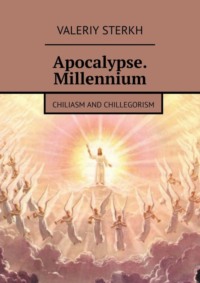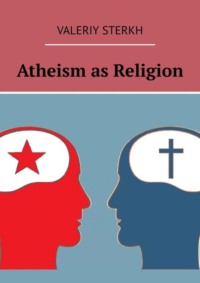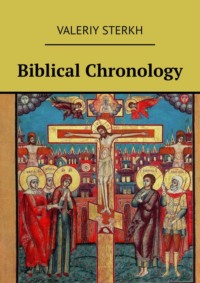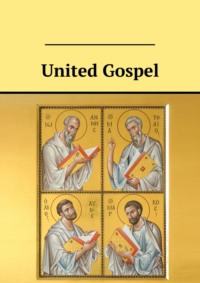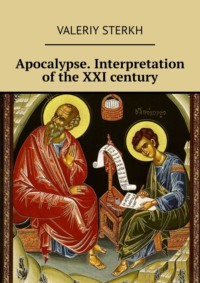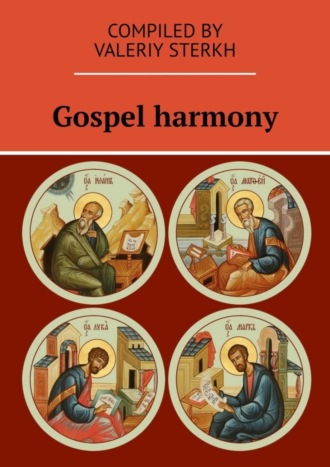
Полная версия
Gospel harmony
b) The principle of maintaining consistency throughout all Gospel narratives
While forming the resulting text from fragments of parallel Gospel episodes, it is not uncommon to see notable differences between them. Some critics have even claimed that there are «contradictions» between the Gospels. However, such claims are not objective enough since the differences do not lead to irreconcilable inconsistencies. In combining such episodes, we must assume that all the evangelists have given us true information so the resulting text will be harmonious with each of the Gospels and will not contradict any of them.
We will now look at how these principles are put into practice.
Genealogy of Joseph
The Gospel of Matthew (Mt 1:1—17) and the Gospel of Luke (Lk 3:23—38) give two genealogies of Joseph, the adoptive father of Jesus. Both genealogies in the area from David to Joseph are clearly different from each other. Here’s what they look like.
According to Matthew (Mt 1:6—16): David, Solomon, Roboam, Abia, Asa, Josaphat, Joram, [Ahaziah (Jehoahaz)], [Joash (Jehoash)], [Amaziah], Ozias, Joatham, Achaz, Ezekias, Manasses, Amon, Josias,
According to Luke (Lk 3:23—31): David, Nathan, Mattatha, Menan, Melea, Eliakim, Jonan, Joseph, Juda, Simeon, Levi, Matthat, Jorim, Eliezer, Jose, Er, Elmodam, Cosam, Addi, Melchi, Neri, Salathiel, Zorobabel, Rhesa, Joanna, Juda, Joseph, Semei, Mattathias, Maath, Nagge, Esli, Naum, Amos, Mattathias, Joseph, Janna, Melchi, Levi, Matthat, Heli, Joseph.
How to harmonize these fragments?
Eusebius of Cesarea wrote the following on the differences in the genealogies: «Because of inconsistencies in the genealogies of Jesus found in Matthew and Luke, there are many Christians who erroneously think of them as contradictory. Many are trying to come up with their own explanations without knowing the truth. Here is what we have learned about them from Aristid’s letter in which [Sextus Julius] Africanus, to whom we recently referred, writes about a way to reconcile the Gospel genealogies. Rejecting the opinions of the rest as erroneous and contrived, he tells a story of what he had heard in the following words:
«In Israel, the names of generations were reckoned either according to the flesh or according to the Law – according to the flesh, when there was a succession of lawful sons, and according to the Law, when a brother of a deceased man, who had died with no sons of his own, would give his child the name of his deceased brother [Deut 25:5—10]. There was no clear hope of resurrection at that time, and so the fulfilment of the future promise was connected to «fleshly» resurrection – so the name of the deceased man would never be blotted out from Israel. That is why some of the ancestors listed in the genealogy were lawful or «natural» descendants of their fathers while others were sons according to the Law, that is, they were born by one father but named after another. And it was customary to mention both – the actual fathers and those whose names were thus restored. So, the Gospels make no mistake in recording their names according to the natural birth and according to the Law. Descendants of Solomon and Nathan were thus intertwined due to the age-long process of «bringing from the dead» those who had no sons, remarrying of the mothers and «restoration of the seed», that one and the same person could be legitimately regarded as a son of his actual father as well as the son of his «sort of» father. Both narratives, therefore, are correct, and they both come to Joseph the right way, though it may seem like a meandering.
To clarify this seeming confusion, I will try to explain what caused it in the first place. If we reckon the generations from David through Solomon, the third one from the end will be Matthan, who begat Jacob, the father of Joseph. According to Luke, the third one from the end, after Nathan, the son of David, was Melki [Matthat (Lk 3:23) – note. V.S.], whose son was Heli, the father of Joseph. Since we are looking at the genealogy of Joseph we must explain why two people are recorded as his father: Jacob, the descendant of Solomon, and Heli, the descendant of Nathan. Why would Jacob and Heli be brothers? And why would their fathers, Matthan and Melki [Matthat], be Joseph’s grandfathers, though they belonged to different lines. Matthan and Melki [Matthat] were both married to the same woman, one after the other, and begat uterine brothers, since the Law didn’t forbid un unmarried woman to remarry, whether she was divorced or widowed. First, Matthan, who was from the line of Solomon, begat Jacob from Esta (this woman’s name according to the Tradition). After Matthan’s death, Melki [Matthat] from the line of Nathan married his widow (as I said, he was from the same tribe but from a different line) and begat his son Heli. So, we will discover that Jacob and Heli were uterine brothers, though belonging to different lines. Heli died without producing children, and Jacob married his wife and begat Joseph (the third generation), who was his son according to the flesh (and according to Scriptures: «Jacob begat Joseph»), and the son of Heli, for his brother Jacob «raised up his seed». So, we must not reject his genealogy. Matthew, the Gospel writer, says: «Jacob begat Joseph». Luke’s genealogy is ascending: «He was the son, so it was thought (he added), of Joseph, the son of Heli, the son of Melki [Matthat]». One could not think of a clearer way to express his sonship according to the Law, so Luke, in speaking about such «births», consistently avoids using the word «beget». His list ends with Adam and God.
All of this is not without a basis and is not arbitrarily contrived. Our Savior’s birth relatives left us the following true story, whether to glorify themselves or purely for our instruction. When a band of marauders from Idumea raided Ashkelon in Palestine, they seized not only the loot from Apollo’s temple, but also Antipater, the son of a certain Herod, who was a hierodule. Because the priest could not redeem his son, Antipater was brought up according to Idumean customs. Later he was well-favored by Hircanus, the high priest of Judea. As an ambassador sent to Pompea on some errand from Hircanus, he obtained for him the kingly authority, which had been usurped by his brother Aristobulus. As to Antipater himself, he prospered; he was appointed the curator (epimelet) of Palestine. After his death – he was murdered out of envy for being so fortunate – his position went to his son Herod. This Herod was later appointed king over the Jews by Antonius and Augustus, as decreed by the Senate. His sons – Herod and others – were tetrarchs. Of these events we also know from the Greek history.
Until then, the archives had kept genealogies of both Jews and ancient Proselytes, such as, for instance, the genealogies of Achior the Ammonite and Ruth the Moabite, as well as genealogies of Egyptians who intermarried with the Jews. Having no connection whatsoever to the Jewish people, Herod, ashamed as he was of his ignoble blood, ordered that all the records of genealogies be burnt in hope that he could be reckoned as a noble-born, if no one was able to trace his line to Patriarchs, Proselytes or Gyiurs (converts to Judaism) using the public records. As a result, there were very few people who retained any memory of their ancestry. If they did, it was by keeping their own genealogical records or just by remembering the names of the ancestors, or keeping their own lists. People were proud of preserving the memory of their high blood. Among them were also the above mentioned «desposiny» – those related to the family of the Lord. Natives of Jewish settlements, Nazareth and Kohaba, they spread wide across the land and compiled the above-mentioned genealogy based on the «Book of Days», as best they could.
Whether it is so or not, it would be hard to come up with a better explanation – this is my opinion as well as that of any reasonable person. To this we will hold, even though it has not been confirmed by evidence – because there nothing better or more correct to hold on to. And as to the Gospel, it is all true, to say the least».
At the end of the same letter, Africanus adds: «Matthan, a descendant of Solomon, begat Jacob. After the death of Matthan, Melki [Matthat], a descendant of Nathan, begat Heli by the same woman. Therefore, Heli and Jacob must be uterine brothers. Heli died childless; Jacob raised up his seed by begetting Joseph who was his son according to the flesh, and Heli’s son according to the Law. So, we can say that Joseph was the son of them both».
This is the testimony of Afrikanus. If such was the genealogy of Joseph, then Mary had to be from the same tribe, for, according to the Law, it wasn’t allowed to marry outside your tribe. The Law said that a man should take a wife out of the same town and the same family so that the inheritance would not go from one tribe to another. With this let us end» (The History of the Church, 1.7).
The explanation offered by Africanus is correct, though he confused Melki with Matthat. The genealogy in Matthew lists births according to the flesh; the one in Luke is according to the Law. It must be added that the levirate links between the two genealogies are found not only at the end, but also in the beginning. This conclusion is obvious because both genealogies intersect in the middle at Zerubbabel, son of Shealtiel (see Mt 1:12—13; Lk 3:27). Nathan was the older brother; Solomon was younger, next in line after him (see 2 Sam 5:14—16; 1 Cron 3:5), therefore he was the first candidate to a levirate marriage (compare Ruth 3—4; Lk 20:27—33). The Old Testament is silent on whether Nathan had children, so we may very well conclude that he had none. Solomon, however, had much capacity for love: «And he had seven hundred wives, princesses, and three hundred concubines» (1 Kings 11:3). So, in theory, he could have married Nathan’s widow. If this is so, Mattatha is the son of Solomon according to the flesh and the son of Nathan according to the Law. In light of the above-mentioned circumstances, the differences between the two genealogies no longer present a problem.
From the above, it is clear that both genealogies are true, but show the origin of Joseph in different ways. Therefore, in accordance with the principle of preserving information, both genealogies should be preserved (see UG 2 [United Gospel, chapter 2]).
The birth of Jesus
The account of Jesus’ childhood is found in both Matthew and Luke. But they tell the story differently.
According to Matthew, the events happened in the following order:
The angel announces the birth of Jesus to Joseph (Mt 1:18—25; UG 8). Jesus is born in Bethlehem, and the Magi come to worship him (Mt 2:1—12; UG 14). Jesus’ family flees to Egypt to escape the wrath of Herod (Mt 2:13—15; UG 15). The massacre of the innocent takes place near Bethlehem (Mt 2:16—18; UG 16). The holy family returns from Egypt and settles in Nazareth (Mt 2:19—23; UG 17).
According to Luke, things happened as follows:
Gabriel announces the birth of Jesus to Mary (Lk 1:26—38; UG 4). Joseph takes his pregnant wife from Nazareth to Bethlehem to participate in the census; Jesus is born (Lk 2:1—7; UG 9). The angel announces the birth of Jesus to the shepherds (Lk 2:8—14; UG 10). The shepherds come to worship Jesus (Lk 2:15—20; UG 11). Jesus is circumcised and named Jesus (Lk 2:21; UG 12). The days of purification; Jesus is brought to the temple (Lk 2:22—38; UG 13). Jesus’ family returns to Nazareth (Lk 2:39; UG 17).
In Matthew, the birth of Jesus is announced to Joseph by the angel of the Lord, but in Luke, the prophecy of Jesus’ birth is announced to Mary by the archangel Gabriel. These are two different annunciations, separated by some time. First, Gabriel appeared to Mary and announced to her that she would conceive from the Holy Spirit (Lk 1:26—38; UG 4). Then she became pregnant, and Joseph found out about it. Next, the angel of the Lord, most likely Gabriel, appeared to Joseph to announce the birth of Jesus and encourage him to accept Mary and her son (Mt 1:18—25; UG 8).
Luke describes Jesus’ family traveling from Nazareth to Bethlehem to participate in the census, and then Mary gives birth to Jesus (Lk 2:1—7; UG 9). Matthew does not give us much detail about the birth of Jesus in Bethlehem (Mt 2:1). Here we see the agreement between the two Gospels.
The subsequent narratives in Matthew and Luke split ways, but they can, nevertheless, be connected by putting the events in chronological order:
The angel announces the birth of Jesus to the shepherds (Lk 2:8—14; UG 10). The shepherds worship Jesus (Lk 2:15—20; UG 11). Jesus is circumcised and named Jesus (Mt 1:25; Lk 2:21; UG 12). The days of purification; Jesus is brought to the temple (Lk 2:22—38; UG 13). The Magi worship Jesus (Mt 2:1—12; UG 14). Jesus’ family flees to Egypt (Mt 2:13—15; UG 15). The massacre of the innocent (Mt 2:16—18; UG 16). Return from Egypt, settling in Nazareth (Mt 2:19—23; Lk 2:39; UG 17).
If you read only Luke’s Gospel, you might get the impression that Jesus’ family went straight from Jerusalem to Nazareth. Matthew, however, says that they first went to Egypt. This seeming contradiction can be explained as follows. Luke writes, «And when they had performed all things according to the law of the Lord, they returned into Galilee, to their own city Nazareth» (Lk 2:39). Matthew talks about the flight to Egypt as a means of fulfilling the prophecy of Scripture: «That it might be fulfilled which was spoken of the Lord by the prophet, saying, out of Egypt have I called my son» (Mt 2:15; compare Hos 11:1). We may well regard the expression «according to the law of the Lord» as «fulfilling the prophecy of the law of the Lord (Scripture)». So, we can easily harmonize these two episodes.
The Twelve
Three out of four evangelists, Matthew, Mark, and Luke, describe the calling of the Twelve by Jesus. The names of the apostles appear in a somewhat different order in each Gospel.
Matthew: «Now the names of the twelve apostles are these; The first, Simon, who is called Peter, and Andrew his brother; James the son of Zebedee, and John his brother; Philip, and Bartholomew; Thomas, and Matthew the publican; James the son of Alphaeus, and Lebbaeus, whose surname was Thaddaeus; Simon the Canaanite, and Judas Iscariot, who also betrayed him» (Mt 10:2—4).
Mark: «And he ordained twelve, that they should be with him, and that he might send them forth to preach, And to have power to heal sicknesses, and to cast out devils: And Simon he surnamed Peter; And James the son of Zebedee, and John the brother of James; and he surnamed them Boanerges, which is, The sons of thunder: And Andrew, and Philip, and Bartholomew, and Matthew, and Thomas, and James the son of Alphaeus, and Thaddaeus, and Simon the Canaanite, And Judas Iscariot, which also betrayed him» (Mk 3:14—19).
Luke: «And when it was day, he called unto him his disciples: and of them he chose twelve, whom also he named apostles; Simon, (whom he also named Peter,) and Andrew his brother, James and John, Philip and Bartholomew, Matthew and Thomas, James the son of Alphaeus, and Simon called Zelotes, And Judas the brother [son – note. V.S.] of James, and Judas Iscariot, which also was the traitor» (Lk 6:13—16).
Let’s put together a harmonized list of the names of the Twelve:
1. Simon (Mt 10:2; Mk 3:16; Lk 6:14; Jn 1:42), the Rock (Mt 16:18; Jn 1:42), or Cephas in Aramaic (Jn 1:42), Peter in Greek (Mt 10:2; Mk 3:16; Lk 6:14; Jn 1:42). Son of Jonah (Mt 16:17; Jn 1:42), brother of Andrew (Mt 10:2; Mk 1:16; Lk 6:14; Jn 1:40). The third disciple of Jesus (Jn 1:35—40). Born in Bethsaida (Jn 1:44). Married (Mt 8:14; Mk 1:30; Lk 4:38; 1 Cor 9:5), had children (Clement of Alexandria. Stromata, 3.6.52).
2. Andrew [the First-Called] (Mt 10:2; Mk 3:18; Lk 6:14). Son of Jonah (Mt 16:17; Jn 1:42), brother of Simon Peter (Mt 10:2; Mk 1:16; Lk 6:14; Jn 1:40). Jesus’ first disciple (Jn 1:35—40). Born in Bethsaida (Jn 1:44).
3. James (Mt 10:2; Mk 3:17; Lk 6:14). Son of Zebedee (Mt 10:2; Mk 3:17; Lk 5:10; Jn 21:2), brother of John (Mt 10:2; Mk 3:17). Both brothers were also called Boanerges, «sons of thunder» (Mk 3:17). The fifth or sixth disciple of Jesus (Mt 4:18—22; Mk 1:16—20; Lk 5:1—11). Born in Galilee (Mt 4:18—22; Mk 1:16—20; Lk 5:1—11).
4. John [the Theologian] (Mt 10:2; Mk 3:17; Lk 6:14). Son of Zebedee (Mt 10:2; Mk 3:17; Lk 5:10; Jn 21:2), brother of James (Mt 10:2; Mk 3:17). Both brothers were also called Boanerges, «sons of thunder» (Mk 3:17). The fifth or sixth disciple of Jesus (Mt 4:18—22; Mk 1:16—20; Lk 5:1—11). Born in Galilee (Mt 4:18—22; Mk 1:16—20; Lk 5:1—11).
5. Philip (Mt 10:3; Mk 3:18; Lk 6:14; Jn 1:43). The second disciple of Jesus (Jn 1:35—43). Born in Bethsaida (Jn 1:44). Had daughters (Act 21:8—9; Eusebius of Caesarea. Church History, 3.31.3).
6. Nathanael (Jn 1:45—50; 21:2), also known as Bartholomew (Mt 10:3; Mk 3:18; Lk 6:14). Son of Talmai [Tholmai] (Aram. «bar Talamai» = «son of Talmai»). The fourth disciple of Jesus (Jn 1:43—51). Born in Cana of Galilee (Jn 21:2).
7. Thomas (Mt 10:3; Mk 3:18; Lk 6:15; Jn 11:16), also called the Twin [Hebrew: Thoma; Greek: Didymos] (Jn 11:16). Probably born in Galilee (Jn 21:1—2).
8. Levi (Mk 2:14; Lk 5:27) Matthew (Mt 10:3; Mk 3:18; Lk 6:15), formerly a tax collector (Mt 9:9; Mk 2:14; Lk 5:27). Son of Alphaeus (Mk 2:14). The seventh disciple of Jesus (Mt 9:9—13; Mk 2:13—17; Lk 5:27—32). Originally from Capernaum (Mt 8—9; Mk 2).
9. James of Alphaeus (Mt 10:3; Mk 3:18; Lk 6:15), also called James the Less (Mk 15:40). Son of «the other» Alphaeus [not to be confused with Levi Matthew’s father] and «the other» Mary; he had a brother named Josiah (Mt 27:56, 61; Mk 15:40, 47). Probably a cousin of Jesus (Mk 6:3; Jm). Born in Galilee (Mt 27:55—56; Mk 15:40—41).
10. Jude (Lk 6:16; Jn 14:22) Levi (Mt 10:3), also called Thaddeus (Mt 10:3; Mk 3:18). Son of Jacob [in some translations: brother of Jacob] (Lk 6:16; Act 1:13). Probably a cousin of Jesus (Mk 6:3; Jude). Probably born in Galilee.
11. Simon the Canaanite (Mt 10:4; Mk 3:18; Lk 6:15), named Zealot (Lk 6:15). Probably a cousin of Jesus (Mk 6:3). Probably born in Galilee.
12. Judas Iscariot (Mt 10:4; Mk 3:19; Lk 6:16; Jn 6:71), who became a traitor. Son of Simon (Jn 6:71). Born in the suburbs of Jerusalem (Heb. «ish-keriyot» = «a man from the outskirts of the city»).
Generally, the lists given by the evangelists agree between each other, but we also have to take into account the fact that some of the apostles had double names.
The legion of demons
The Gospels of Matthew, Mark, and Luke contain an account of the demon-possessed man healed by Jesus near the Lake of Gennesaret (Mt 8:28—34; Mk 5:1—21; Lk 8:26—39; UG 66). Each Gospel gives different details about this episode. Let us first consider similarities between them.
These events take place after the taming of the storm on the Lake of Gennesaret (Mt 8:18—27; Mk 4:35—41; Lk 8:22—25; UG 65). The episode takes place on the opposite shore from Galilee, in the country of the Gadarenes, or Gergesenes (Mt 8:28; Mk 5:1; Lk 8:26). In this area, there were mountains with cave tombs that were used by the demon possessed men and women as shelters (Mt 8:28, 32; Mk 5:2, 13; Lk 8:27, 33). Jesus healed the man by casting out the demons and sending them into the pigs. The pigs threw themselves into the lake (Mt 8:30—32; Mk 5:11—13; Lk 8:32—33). Obviously, it is one and the same event.
Matthew tells the story in brief, mentioning two demoniacs (Mt 8:28) healed by Jesus. Mark and Luke give more detail but mention only one man possessed by many demons (Mk 5:2; Lk 8:27). According to Mark and Luke, there was a legion of demons (Mk 5:9; Lk 8:30). Mark goes on to say that the number of demons was about two thousand (Mk 5:13). Considering that a Roman legion consisted of 2,000 to 10,000 infantrymen, it is no exaggeration. However, Mark and Luke seem to disagree with Matthew’s statement about the two demoniacs.
The principle of harmonization says that the resulting text should not contradict any of the Gospels. Since Matthew was one of the Twelve and most likely an eyewitness to what happened, we can fully trust his account of the two demoniacs without raising questions. Matthew does not mention the legion of demons or their number. But he says that the exorcised demons were sent into a large herd of pigs (Mt 8:30; compare Lk 8:32). Here he comes close to Mark and Luke.
According to Mark and Luke, there was only one demoniac who approached Jesus. There was a legion of demons speaking through him (Mk 5:12; Lk 8:31). From Matthew’s account, one can infer that the legion of demons spoke to Jesus all at once (Mt 8:29, 31). Again, we see that the accounts come quite close to each other.
Could it be that Mark and Luke mentioned only one demoniac because only one approached Jesus, or maybe because he was more ferocious than the other one or had more demons? Possibly. But it doesn’t seem to be the main reason. The clue seems to appear at the end of Mark and Luke’s accounts where only one of the healed returned to thank Jesus and asked if he could follow him. When Jesus said no, he went off and started talking about what had happened (Mk 5:18—20; Lk 8:38—39).
From this perspective, the differences in the accounts of the evangelists seem negligible.
The withered fig tree
On Monday of Holy Week, Jesus was hungry and, coming up to a fig tree and finding no fruit, cursed it (Mt 21:18—22; Mk 11:12—14, 11:20—26; UG 143, 145). According to Matthew, the fig tree withered immediately (Mt 21:19). Then he says, «And when the disciples saw it, they marvelled, saying, How soon is the fig tree withered away!» (Mt 21:20). In Mark, the apostles found the fig tree withered only on the following morning (Mk 11:20). Is there an irreconcilable contradiction here?
Since Mark specifies the moment of discovering the withered fig tree precisely (Mk 11:20) and Matthew is vague (Mt 21:20), it would make sense to give preference to Mark’s version here. As to the actual time the fig tree withered, Matthew seems more accurate (Mt 21:19) while Mark only mentions that the disciples heard the curse (Mk 11:14).
We might speculate that the fig tree withered soon after Jesus had cursed it, but the disciples only saw it the next day. In this case, the apparent contradiction is removed.
Generally, the two evangelists present their narratives differently. Mark relates the story in chronological order, capturing Peter’s memories in exact detail. Matthew tells the fig tree story in the form of a parable, alluding to Luke’s parable of the barren fig tree (Lk 13:6—9; UG 113). That is why Matthew presents the episode as a whole, while Mark divides it up into two parts with the story of the temple cleansing stuck in between (Mk 11:15—19; compare Mt 21:12—17; Lk 19:45—46; UG 144). Matthew places the fig tree account after the account of driving out the merchants because the ending of the fig tree story happened after it. This may give the impression that Jesus first drove out the merchants and then cursed the fig tree, but in Mark, the cursing of the fig tree preceded the cleansing of the temple. This «inconsistency» can be explained by Matthew’s desire to present the story in the form of a parable.
Конец ознакомительного фрагмента.
Текст предоставлен ООО «ЛитРес».
Прочитайте эту книгу целиком, купив полную легальную версию на ЛитРес.
Безопасно оплатить книгу можно банковской картой Visa, MasterCard, Maestro, со счета мобильного телефона, с платежного терминала, в салоне МТС или Связной, через PayPal, WebMoney, Яндекс.Деньги, QIWI Кошелек, бонусными картами или другим удобным Вам способом.




